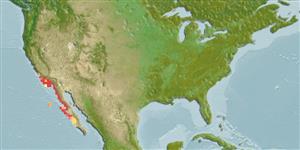Actinopterygii (ray-finned fishes) >
Perciformes (Perch-likes) >
Clinidae (Clinids)
Etymology: elegans: Gibbonsia in honor of Dr. William P. Gibbons, one of the early naturalists at the California Academy of Sciences; elegans meaning elegant (Ref. 4930).
Environment / Climate / Range
Ecology
Marine; demersal; depth range ? - 56 m (Ref. 96339), usually ? - 20 m (Ref. 101760). Subtropical, preferred ?; 36°N - 22°N, 121°W - 110°W
Eastern Pacific: Piedras Blancas Point in central California, USA to southern Baja California, Mexico, including Guadalupe Island.
Size / Weight / Age
Maturity: Lm ? range ? - ? cm
Max length : 16.0 cm TL male/unsexed; (Ref. 2850)
Found from subtidal rocky areas to 56 m depth, usually in seaweed. Female lays white eggs in seaweed, male guards egg mass (Ref. 2850).
Life cycle and mating behavior
Maturity | Reproduction | Spawning | Eggs | Fecundity | Larvae
Oviparous (Ref. 101760). Eggs are attached in algal nest and brooded by male parent (Ref. 101760).
Eschmeyer, W.N., E.S. Herald and H. Hammann, 1983. A field guide to Pacific coast fishes of North America. Boston (MA, USA): Houghton Mifflin Company. xii+336 p. (Ref. 2850)
IUCN Red List Status (Ref. 115185)
CITES (Ref. 94142)
Not Evaluated
Threat to humans
Harmless
Human uses
More information
Age/Size
Growth
Length-weight
Length-length
Length-frequencies
Morphometrics
Morphology
Larvae
Larval dynamics
Recruitment
Abundance
ReferencesAquacultureAquaculture profileStrainsGeneticsAllele frequenciesHeritabilityDiseasesProcessingMass conversion
Tools
Special reports
Download XML
Internet sources
